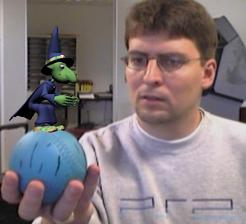
The display technology for video games has improved at a fantastic rate, but little change has been made to the user interface. Most games still assume the only interface available is a gamepad/joystick or a mouse/keyboard. New input methods such as voice and video enable a new level of interactivity. Increased CPU power and reduced hardware costs have recently made such interfaces commercially viable, even just as enhancements (not replacements) to the baseline interface. Recent highly-successful examples include the SOCOM headset and EyeToy.
This talk will describe how the EyeToy went from a research project to a high-profile product that has sold millions. It will also include a brief high-profile product that has sold millions. It will also include a brief presentation of the speaker's current research into video interfaces. Several live technology demonstrations will be shown using PlayStation2 and EyeToy, including gesture recognition for spell casting, head tracking for hover-board and first-person strafe control, and a real-world "Minority Report"-inspired interface.
About the speaker:
 | Richard Marks was an Avionics major at MIT before getting his PhD at Stanford in the Aerospace Robotics Lab. His thesis was in conjunction with the Monterey Bay Aquarium Research Institute, in the area of visual sensing for automatic control of an underwater robot. He then joined Teleos Research, a computer vision start-up that was later acquired by Autodesk. He departed and consulted for a year, before the unveiling of the PlayStation2 hardware inspired him to join PlayStation R&D. His research focus has been studying real-time video input to the PS2, and he is credited as the inventor of the EyeToy technology. Richard now manages the Special Projects group of Sony Computer Entertainment US R&D, which includes Man-Machine Interfaces and Physical Simulation research. |
Contact information:
Richard Marks
Sony Computer Entertainment US R&D (Playstation)
Richard_Marks@Playstation.sony.com